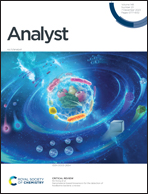Evaluation of Raman spectroscopy combined with the gated recurrent unit serum detection method in early screening of gastrointestinal cancer†
Abstract
Gastric and colorectal cancers are significant causes of human mortality. Conventionally, the diagnosis of gastrointestinal tumors has been accomplished through image-based techniques, including endoscopic and biopsy procedures coupled with tissue staining. Most of these methods are invasive. In contrast, Raman spectroscopy has the advantages of being non-invasive and label-free and requiring no additional reagents, making it a potential tool for the detection of serum components. In this study, we collected Raman spectra of serum samples from patients with gastric cancer (n = 93) and colorectal cancer (n = 92) and from healthy individuals (n = 100). Analysis of Raman peak areas revealed that cancer patients had significantly higher peak areas at around 2923 cm−1 compared to normal individuals, which corresponded to the presence of lipids and proteins. We successfully achieved the early screening of gastrointestinal tumors using the improved gated recurrent unit (GRU) algorithm and traditional machine learning methods. The accuracy of identifying digestive tract tumors using different recognition models exceeds 84.72%, with support vector machine (SVM) and GRU achieving 100% accuracy. The use of GRU further demonstrated its ability to differentiate subtypes of gastric and colorectal cancers based on the degree of differentiation and stage, with a recognition accuracy exceeding 95%, which is challenging using traditional machine learning methods. Furthermore, our study revealed that principal component analysis (PCA) dimensionality reduction has a limited impact on the recognition results obtained using different recognition models.



 Please wait while we load your content...
Please wait while we load your content...